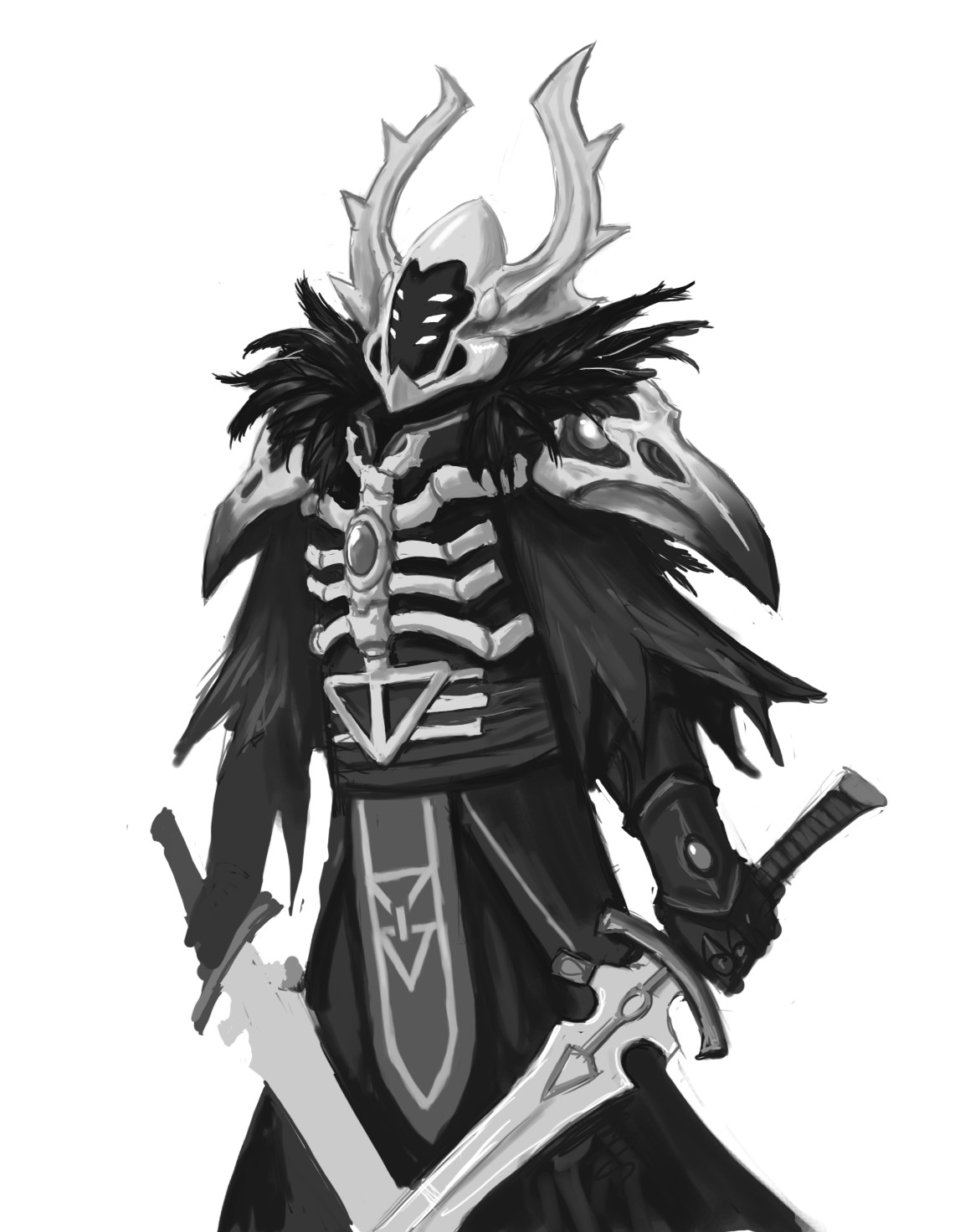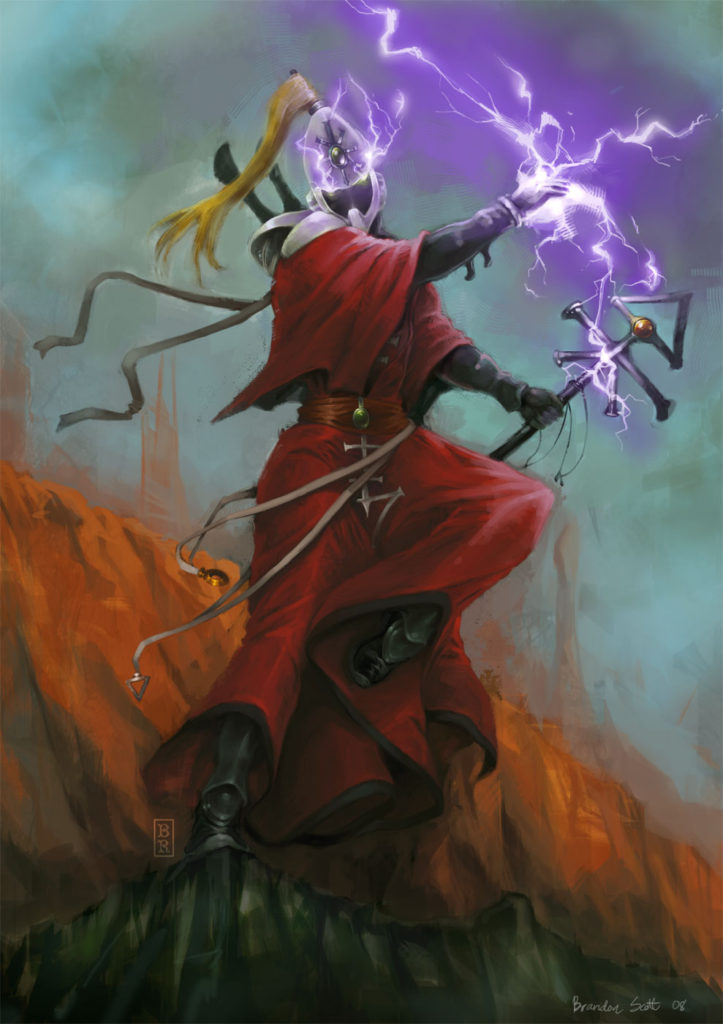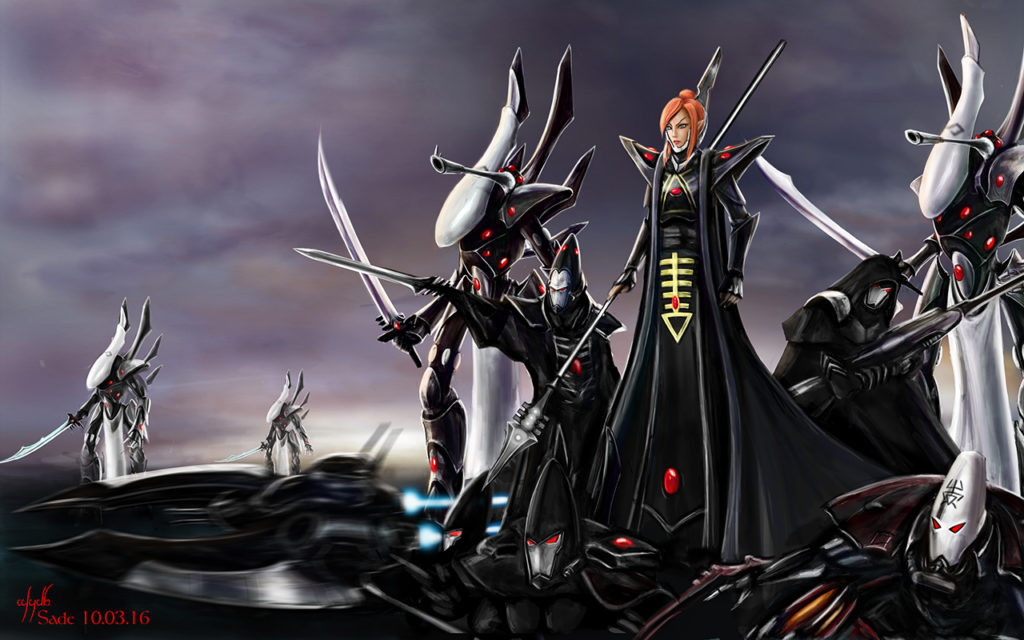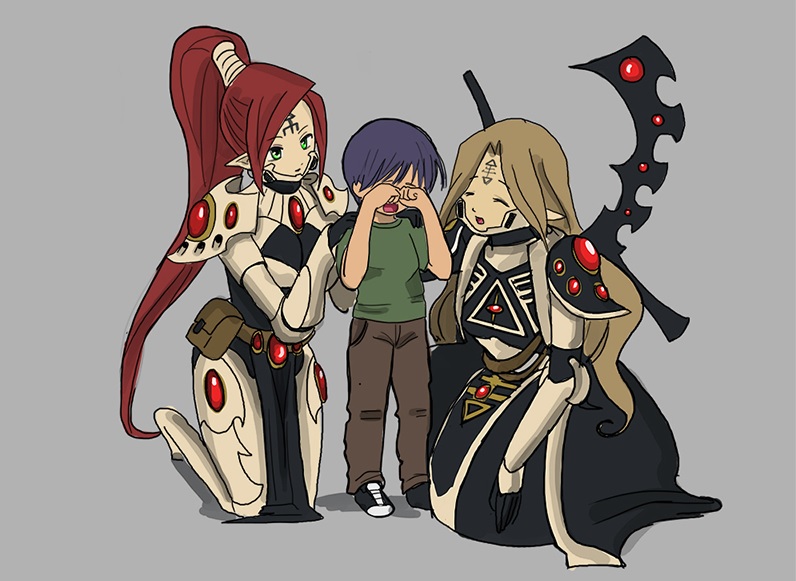A warlock is a male witch, but a Warlock can be male or female and has absolutely nothing to do with Wyches. This shouldn’t be confusing at all. Click to read the CA2018 updated version of the article, or check out more reviews and strategies at the Tactics Corner.
Overview
The Warlock is the cheapest HQ available to the Craftworlds codex- and, indeed, one of the cheapest HQs in the whole of the game. Coming in at 55pts, a Warlock can fill a slot for perhaps half of what most factions pay, though in many ways you only get what you pay for with them. Warlocks come with a fairly mediocre statline- weapon skill and ballistic skill 3+, giving them a respectable offensive potential, but only strength and toughness 3. Two wounds and two attacks is about as low as any HQ can possibly get, and with only a 4+ invulnerable save for protection, Warlocks are not exactly the sturdiest of characters; in fact, a lot of basic infantry outclass them pretty handily in this respect.
There also is the option for a Warlock Skyrunner, the jetbike-mounted variant of the character; they are identical to the basic version, but benefit from all of the usual upgrades for a jetbike- 16″ movement and the Fly keyword, 6″ automatic advance, and an extra point each in toughness and wounds. For only 12pts above and beyond the normal cost of a Warlock, it’s a very attractive proposition, with the only real downside being losing your infantry status (and thus the ability to move through ruins or embark on vehicles.)
Special Rules and Wargear
Like all Craftworld Eldar, warlocks (and their Skyrunner cousins) come with Battle Focus and Ancient Doom, both of which are fairly beneficial rules in the most general sense, though not quite as specifically applicable to their roles. Both versions also get a Shuriken Pistol and Witchblade (always wounds on a 2+, d3 damage), the latter of which can be swapped for a Singing Spear for 5pts in order to give an extra ranged attack with the same profile.
Aside from that, Warlocks don’t really have any options or abilities to speak of; they are pretty much one-trick ponies, good only for their spellcasting. However, when your spellcasting is this strong, it’s probably fine. Each warlock can cast/deny one power per turn and gets a single choice off of the Runes of Battle table… however, each Runes of Battle choice comes with two powers, a buff and a debuff. All the buffs target a Craftworld infantry or jetbike unit within 18″, whereas the debuffs can target any enemy unit. Both powers are considered separate spells, so if two Warlocks have the same power chosen, you can potentially have each of them set off a different “half” in the same turn. Warlocks also know Smite, though when they cast it the spell only has a 9″ range and deals a single mortal wound, so it’s a pretty low-priority choice.
Conceal/Reveal (WC7) is a good starting point, giving -1 to hit on anything that shoots at a unit or negating all cover bonuses on a unit. While Reveal is a pretty mediocre spell (and is strictly worse than Jinx), Conceal is excellent when slapped on a key unit. In combination with the Alaitoc trait it can really go buck wild, all the more so if the enemy is suffering other penalties (from moving, from innate abilities, from stratagems, etc.) Especially combined with Protect and/or Fortune, Conceal can make a unit incredibly difficult to kill and is thus a great choice for high-priority targets such as Shining Spears, Wraithguard, Shadow Spectres, etc.
Embolden/Horrify (WC6) is more niche, but not without its uses. Granting +2 to the leadership of an Eldar unit or -1 to the leadership of an enemy unit, it isn’t particularly impressive on its own- but combined with Mind War, Shadow Spectres, or other debuffing/leadership-dependent effects, it can be quite effective. The key, as always with the army, is to stack modifiers in order to do your work for you; if you can kill two Space Marines and let morale take care of the other three, you’re in a pretty good place. With that said, you’re not usually going to bother with Embolden/Horrify unless you’re building specifically for it, so generally it isn’t worth considering.
Enhance/Drain (WC6) is somewhat more broadly-applicable, though it still isn’t a prime choice due to Craftworlds not really being a melee-primary army. Still, the effect is good- either +1 to hit for a friendly unit or -1 to hit for an enemy unit. While the innate bonus itself is useful (especially for turning some less-accurate units like Wraithblades with Axes back up to where you’d like them to be), the real clutch part is triggering effects that work on a 6+ more often or turning them off for the enemy. With Enhance, the Supreme Disdain stratagem becomes really worth using, as it can proc a lot of extra attacks- likewise with Striking Scorpions Karandaras, and Ambush of Blades. You can also use it to deny enemies such bonuses- a bit situational, but not bad- or simply to slow down a nasty unit. In hopes of making them choose not to multicharge, or not deal enough damage to wipe something out. Unfortunately, it’s not terribly useful against a lot of the hard-hitting HQ characters, as they tend to be hitting on 2s most of the time. As always, it’s particularly effective when stacked with other bonuses/penalties- slapping Drain onto a unit of Conscripts right before some Banshees charge into them is a pretty hilarious thing to watch.
Protect/Jinx (WC7) is one of your real money powers. Protect, which gives +1 to all saves on a target unit, is a solid choice- especially for anything with an invulnerable save or that is under the effects other any other protective powers. Shining Spears or Wraithblades with 2+/3++ can be very difficult to get rid of, as can a unit of Guardians rocking a 3++ from Celestial Shield. As good as that can be, however, Jinx is even better- it gives an enemy unit -1 to all saves, which can absolutely devastate a centerpiece of the enemy army like a Magnus, Mortarion, Knight, or even just a big block of Berzerkers. Slapping Jinx onto a target all but guarantees they die this turn if you put any other effort into it, as even resilient characters or big vehicles will go down quickly. I won’t run the math here, but reducing enemies with a 3+ to a 4+ is brutal even for just basic weapons, and reducing those 4+ ones to 5+s is even more so. Jinx is a spell that spells the end of a unit, and it should be one of your go-to choices for a Warlock.
Quicken/Restrain (WC7) is your other obvious selection. Although it doesn’t have quite the brutal hitting power of Jinx, it can still be a game-winner. It combines two of the best effects from other factions together into a single spell that you won’t want to leave home without a lot of the time: Quicken is largely identical to Warptime, from the CSM faction- it gives one unit a free move, though at a longer range and with more restrictions. Great for throwing a unit into combat, either from a distance where the enemy didn’t expect them or by jumping past some screening units to get deep into their lines, you’ll cause a lot of people headaches by dropping units in on them and assaulting when they aren’t ready for it. Restrain, which less impressive on the surface, is arguably even a better power- it halves the movement value of an enemy unit, slowing them to a crawl. While it might not be exceptionally impressive on something like basic infantry (cutting 6″ to 3″), even there it can be big if they are at a distance from your forces- turning an 8″ charge into an 11″ charge will really tilt the odds. The gold, though, is once again when you face a big, fast, nasty guy like a demon primarch; bringing Mortarion down to a 6″ move speed means he’s not going to be getting to you on his own anytime soon, giving you plenty of time to assassinate his Warptime provider and grind him down. On anything that wants to move fast, Restrain can prevent this- and even just delaying a key unit for a turn or two can make an enormous difference in your game plan. You are hard-pressed not to want Restrain in your army.
Empower/Enervate (WC6) is last on our list, and it’s an interesting choice. With +1 to wound for a friendly unit in melee, or -1 for an enemy, it can go a long ways towards mitigating the weak strength/toughness stats of most Eldar models. Like with Enhance/Drain, the biggest trick with it is using it to make special abilities trigger more often (or prevent them from triggering)- however, Eldar don’t have a whole lot of those to lean on, so in that respect it’s a lot less impressive. On the other hand, with units like Howling Banshees or Striking Scorpions, it can really up your damage potential, which is super-helpful as wounding enemy units on 5s or 6s is really quite garbage. The only caveat is that it shares a role in this respect with Doom, which is almost always a superior spell- so probably you’re picking something else first, and getting Empower/Enervate with an “extra” slot to support it.
Uses
So the big question everyone always asks is “why would I take a Warlock when I could take a Spiritseer instead?” And it’s a valid question- for ten points more, a Spiritseer offers two more wounds, superior weapon and ballistic skill values, and a full-power Smite rather than the crappy Destructor one. For such a small cost, those are a lot of upgrades, so why wouldn’t you take them? Well, most of the time, you wouldn’t. Spiritseers, generally speaking, are better than Warlocks. They cost about the same, and they are better in the ways that matter.
But there are some important situations where you’re going to want to or need to take a Warlock, and I think those are worth remembering. First off, Warlocks are cheaper- ten points may not be a lot, but it can be enough to make a difference in a list. Sometimes you just have to shave off a couple points to fit something into the army and there’s no better place to cut those points from- in these cases, taking a Warlock may not be terribly appealing, but it’s at least a choice you have. Second off, Warlocks qualify for several stratagems that Spiritseers don’t- most notably the Seer Council stratagem. If your list relies heavily on casting a particular power at a particular time, you’re going to want every advantage you can get in order to set it off- so a +1 bonus might not be exciting, but it’s still something you should aim for, because leaving those Howling Banshees or Shining Spears sitting out in the middle of the field like idiots is gonna make you feel real bad otherwise. Third, as mentioned before Warlocks have access to Jetbikes and Singing Spears, both useful options in certain circumstances (especially in combination); being able to move 22″ to where you need to be to cast a power is a very helpful thing. A Spiritseer is probably the “default” option for gaining access to the Runes of Battle powers, but it’s worth remembering that Warlocks exist as well.
Because that is exactly why we take a Warlock- we want one or more powers off the Runes of Battle list, and Farseers can’t get them, nor can most other units. Runes of Battle is arguably one of the strongest tables in the game, with both buffs and debuffs that can make or break particular units. With Warlocks being such cheap casters, I think a lot of Craftworlds armies are going to have good reason to take one or two of them- and the fact that they are so inexpensive also makes opening up additional detachments much easier, which gives a Craftworlds army access to more command points than you might otherwise expect.
From a competitive perspective, Warlocks are very important as well, because they offer solutions to many of the major contenders in the game right now. As we’ve talked about several times, spells like Jinx and Restrain can be absolutely key to shutting down certain types of lists that rely on very big threats to do a lot of their work for them- and for a pretty small investment you can get a good chance of doing that. Now, they aren’t the only or necessarily best solution to some of these armies (we’ll talk about some of the other options in later articles), but they are at least one of the ways to handle them.
Countering
Stopping a Warlock is, to put it bluntly, pretty easy. Though the buffs they give to other units are quite strong, they themselves are incredibly weak and easy to get rid of under most circumstances. T3/4++ and two wounds just isn’t that much, so basically as soon as they are targeted by anything they will die. The Skyrunner version is little better, since it still falls at the very bottom tier of where we generally expect HQs to be. So if you can shoot/assault a Warlock with anything more than a single model, you can probably finish them off.
Beyond that, defenses against casting are very effective on them- anything that ups the chances of Perils or decreases the chances of succeeding on a spell is going to be tough times for a Warlock. Perils has a two-thirds chance of finishing a Warlock off by itself and triggering the d3 mortal wounds to nearby units, so it is exceptionally effective, but even just penalties to casting (like Shadow in the Warp) are a big deal because so many of the Warlock’s spells have such high casting values. Even if they’re not dead, a psyker who fails all their spells may as well be dead for most purposes.
You can also mitigate the effects of a Warlock’s powers by denying them easy targets for debuffs- 18″ range on their powers is certainly not particularly low in the context of psychic powers, but when it comes to ranges on the battlefield it’s definitely on the short side of things. Unless they’re mounted on a bike (a luxury most generals won’t pay for), Warlocks are going to struggle to reach deep into your lines when casting their debuffs, so holding back key pieces can help a lot. On the flip side of things, if your list doesn’t include a huge, central target that you base your whole army around, you’re going to be a lot better off against a Warlock- Jinx is a great spell when cast on a superheavy, but less so when you’re putting it on a minimum Tactical Squad.
Final Thoughts
Although Warlocks aren’t a prime option in the codex, they’re definitely one you’ll consider fairly often. While other units might have superior stats or options, a Warlock brings the powers you need for a very cheap price, and that’s something that is extremely valuable to have in a list. Expect to see Warlocks in lots of types of Eldar armies, even if it’s not every single one out there.
And remember, Frontline Gaming sells gaming products at a discount, every day in their webcart!








I am a huge fan of Warlocks due to the synergy they have with Farseers via stratagems. The more I play the council though, the more I prefer it. However, I have a lot of reps with the solo Warlock and Bikelock and have really enjoyed both.
I definitely do use the basic Warlock often enough; the +1 to cast is useful when you _have_ to get a power off, though overall it’s not a unit I am thrilled with taking. Still, it serves its purpose.
(For those curious, Conclave has its own article coming as well.)
I actually haven’t used the Skyrunner versions much at all this edition; the price drop from the Index is appreciated, but if I’m dropping 65+pts on an HQ, I think Eldar have access to a lot of other options.
Fair points. I have definitely gone over to the Conclave for general use these days. I find a unit of 4 to be really dang good.
I prefer the bike lock most times of the spiritseer. Access got he stratagem so very nice.
From there more wounds dont mean much of anything on a character as they are pretty dead if anyone can shoot at them. That said stiff like bolt of change fro. Tzeench can threaten them due to low wounds.
I really enjoy the bike HQs as well. Have them hang out between your fliers can force your opponent to have to kill the fliers to table you. Letting you get past sudden death, and advancing bikes are fast enough to keep up with the fliers.
One important difference is the jump from three wounds to four means a lot when suffering Perils, as a four-wound model will never “explode” and kill nearby units unless they’ve taken other damage first.
That’s fairly true, though you don’t really have much or any reason to have the warlock near anyone. He just chill out in a nice whole by himself. As long as has some one in front of him and behind him, he can’t be targets. So, the perils explosion only effects thee warlock.
From there looking at the odds you perils 5.54% of the time and even on that only 1/3rd of those perils are gonna kill your warlock. So 1.82% of his cast he’ll kill himself.
SO both of those make me just not too worried about perils as while it sucks when it happens. The impact is relatively low.
Revisiting this one, I was wondering if there’s any point to the solo foot Warlock with the latest point updates? Both the Spiritseer and Warlock on bike are now only marginally more expensive.
At this point? Not realistically. If you want to be able to guarantee your spells with Seer Council, pay the handful of points more for a Skyrunner. If you just want a caster who can hide inside a Wave Serpent, take a Spiritseer. The foot Warlock is functionally dead.
Not really. Their strats are what you take them for and the footlock still gives you access to them.
You can put the foot version in a transport and keep him safe.